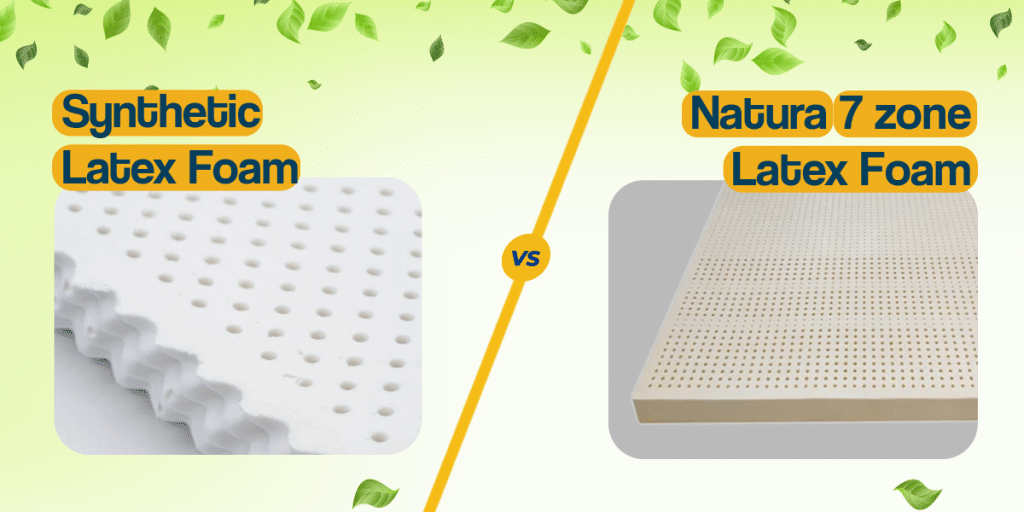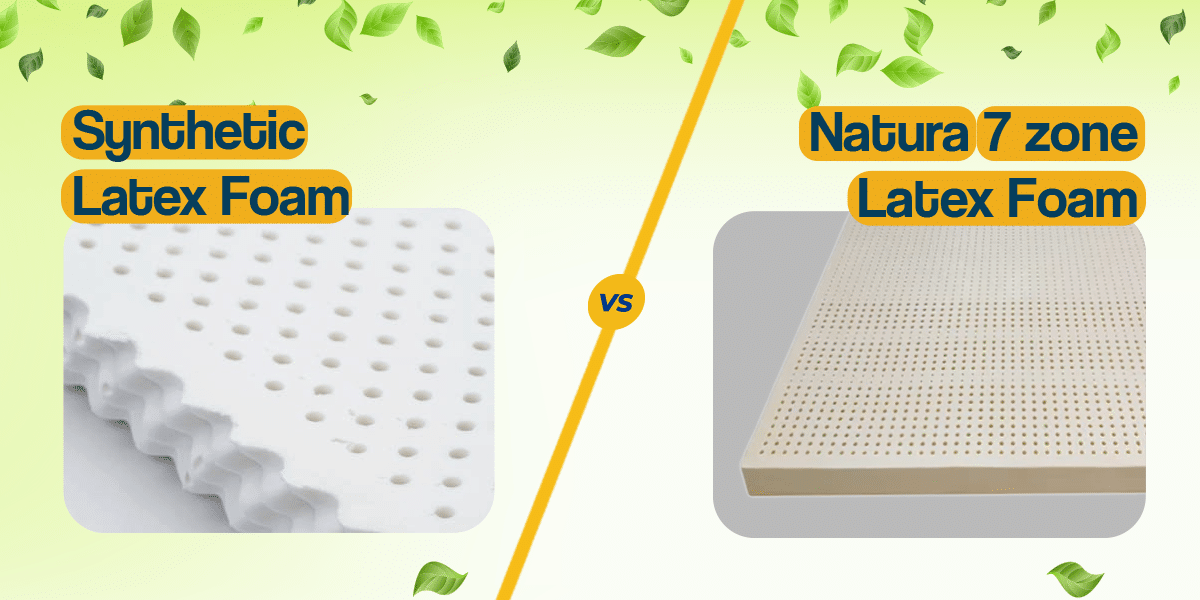
Introduction
A mattress is only as good as the material used in its making, so it is ideal to be sure of the material that is to be used. It is not surprising, however, that latex mattresses are regarded as one of the most comfortable and long-lasting beds. There are two main types of latex incorporated in mattresses: natural latex and synthetic latex. Both have unique characteristics and pros, but before choosing between them, it is essential to know their differences.
This detailed guide discusses the key differences between natural latex vs synthetic latex, to assist you in making the right choice before making a purchase.
Understanding the Differences Between Natural and Synthetic Latex
The main difference is in the composition. Natural latex is derived from rubber trees; on the other hand, synthetic latex is manufactured from chemicals using intermediates derived from petroleum. These differences define not just how a mattress made from these materials feels and performs but also its sustainability, pricing, and overall productivity.
Let’s examine them individually and try to understand the advantages and disadvantages of each type.
What Is Natural Latex?
Natural latex is a natural and organic product obtained wholly from the rubber tree’s sap. The sap can then be treated by means of Dunlop or Talalay processes to transform it into a comfortable and reliable mattress cushioning material.
Using only organic materials, natural latex foam mattresses have a smaller cooling footprint and are, as a bonus, dust mite—and mould-resistant. This puts them ahead of the competition for those looking for a more ethical and environmentally friendly sleep solution.
What Is Synthetic Latex?
Synthetic latex results from a complicated synthesis of primarily synthetic latex rubber and a mix of petrochemicals. It replicates some aspects of the qualities of natural latex but is less tough and might not have the same elasticity.
Because of their even feel, which is perfect for those on a tight budget, synthetic latex mattresses are cheaper to manufacture and are a better option for customers looking for savings.
Features & Advantages of Natural Latex Mattresses
- Eco-Friendly: Natural latex is biodegradable, sustainably harvested, and produced, making it a great product for environmentally friendly consumers.
- Durability: The use of high-quality material ensures the durability of natural latex mattresses
- Comfort: Natural latex mattresses are comfortable and provide appropriate contour support to relieve pressure points.
- Health Benefits: Natural latex is well known to not harbour allergens, dust mites, or mould, thus making sleeping on it cleaner.
- Temperature Regulation: Due to their high level of breathability, such mattresses can provide a cooler sleep, which is not the case with synthetic mattresses.
Key Differences Between Natural Latex vs Synthetic Latex Mattresses
| Feature | Natural Latex | Synthetic Latex |
|---|---|---|
| Material | Harvested from rubber trees | Made from petrochemicals |
| Durability | Highly durable | Moderate durability |
| Comfort | Exceptional body contouring | Uniform feel |
| Cost | Higher | Lower |
| Eco-Friendliness | Environmentally sustainable | Less eco-friendly |
| Hypoallergenic | Naturally hypoallergenic | May require additional treatments |
Hybrid Options in Latex Mattresses
If you are still struggling to decide between natural latex vs synthetic latex, then hybrid mattresses will suit you the most. Best latex hybrid mattresses are composed of one or more layers of natural latex, synthetic latex or memory foam combined with inner springs, making them beneficial in every possible way. For the ones looking for mattresses that are durable, affordable, and provide customisation comfort features, hybrid options would be the best choice. Centuary Mattress offers hybrid latex mattresses that meet diverse sleep needs without compromising quality.
Choosing the Best Latex Mattresses: Natural, Synthetic, & Hybrid?
When selecting natural latex mattresses, synthetic latex mattresses, or hybrid latex mattresses, things such as cost, availability, and ecological factors should be considered. For those who appreciate the environment and seek something that lasts, go for natural latex without a doubt. However, if price factors are more than consistency in feel, synthetic latex mattresses work well. For added customisation and affordability, hybrid mattresses are a great option. Centuary Mattress offers a range of products that guarantee that every option is fulfilled with care and accuracy.
Conclusion
Natural latex or synthetic latex, it all comes down to your individual needs and preferences. Natural latex mattresses are environmentally friendly, long-lasting, and have other health advantages, while synthetic latex rubber mattresses are cheaper and uniform. Hybrid solutions deliver a diversity of needs in between. No matter what your selection is, rest assured, Centuary Mattress premium latex mattresses will make sure you get good quality sleep. Explore their collection today for a personalised sleep experience.
FAQs
The best option is determined by a person’s expectations. Natural latex mattresses are environmentally friendly, long-lasting, and provide excellent comfort. On the other hand, synthetic latex mattresses are cheaper and have a more uniform feel. Natural latex is good for those who prefer getting a mattress and using it over a long period of time. However, those looking for economy would be better off considering synthetic latex. Centuary Mattress has options for both and still maintains quality and satisfaction.
Yes, in most cases, natural latex mattresses have longer lives than synthetic latex ones. Natural latex can hold on to its structural shape and elastic qualities for many years, so purchasing it would be a reasonable idea. However, due to chemical bonding, synthetic latex mattresses may decompose at an accelerated rate.
Rubber trees are the raw material for natural latex mattresses, which are renewable resources. They can decay naturally and emit less carbon than synthetic latex. Natural latex is also produced with fewer destructive factors, so it is eco-friendly.
Synthetic latex mattresses do provide some of the essential features, such as elasticity and strength, that are provided by natural latex, but the former may not be able to provide the latter attributes to the same degree as natural latex. They provide consistent feeling but lack natural comfort and hypo-allergic features like natural latex.

